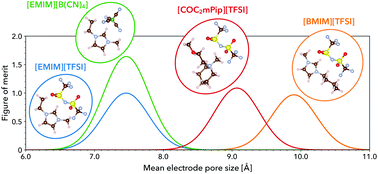Theory-augmented informatics of ionic liquid electrolytes for co-design with nanoporous electrode materials†
Abstract
Ionic liquids possess compelling properties and vast chemical diversity, promising unprecedented performance and tunability for advanced electrochemical applications in catalysis, sensing, and energy storage. However, with broad tunability comes intractable, multidimensional parameter spaces not easily traversed by empirical approaches, limiting both scientific understanding and technological breakthroughs with these novel materials. In this Communication, we propose an extensible figure of merit that co-optimizes key ionic liquid properties, including electrochemical stability window, viscosity, and molecular ion size with respect to pore sizes of nanoporous electrodes typically utilized in electrochemical technologies. We coupled density functional theory (DFT) with informatics to augment physiochemical property databases to screen for high-performance room-temperature ionic liquid (RTIL) candidate compounds. This co-design framework revealed a number of promising RTILs that are underrepresented in the literature and thus warrant future follow-up investigations.



 Please wait while we load your content...
Please wait while we load your content...